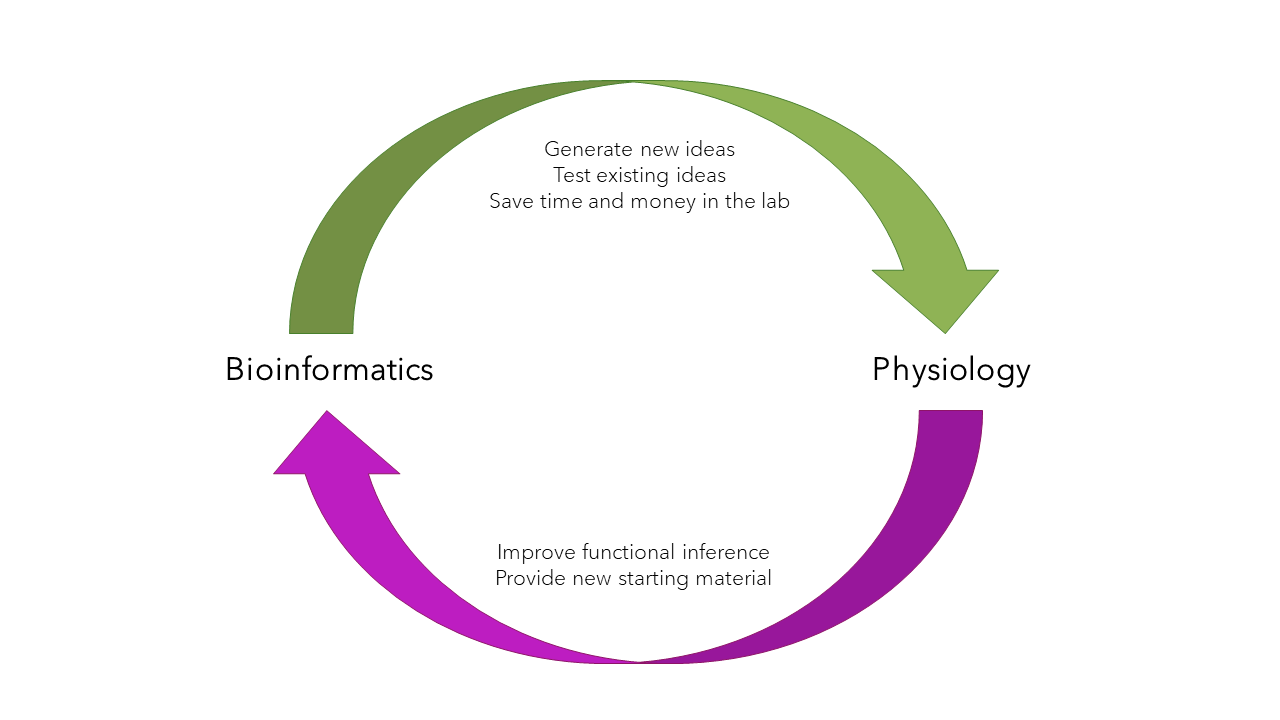Physiology and bioinformatics: oil and water?
As a scientist, I am a walking paradox. I should not exist. Like a scientific centaur, I am half-physiologist half-bioinformatician, a chimera of two disciplines that don’t tend to mix. A bit tongue-in-cheek, perhaps, but it’s true. Have a look at some data:
Percent of publications from Jan 2010 to Sep 2021 containing the term “bioinformatics” in different field-specific journals:
- Nature Genetics: 29.2%
- Nature Microbiology: 18.4%
- Journal of Neuroscience: 4.2%
- British Journal of Pharmacology: 2.7%
- Journal of Physiology: 1.5%
Comparably, physiology just doesn’t include much bioinformatics work (at least not using the term explicitly). I’ve been thinking about why that is and I feel that there are a few ways in which the two fields differ that may contribute to their mutual exclusion:
(a) History
Physiology is an old science. If you squint hard enough, you can see traces of it in ancient Greece, sense it taking form in the writings of Aristotle and follow it slowly developing into the foundations of modern medicine. Compared to physiology, bioinformatics is but a day old. Born out of necessity to deal with the heaps of data generated by biological scientists, bioinformatics has taken the scientific world by storm. It is the fashionable new kid on the block, the lifeboat saving us from drowning in a sea of data.
(b) Context
Physiology is obsessed with function. As such, physiologists perhaps more than any other type of biologist rely on living things – cells, tissues, organisms – that can be probed for function. All of this requires hands-on experimentation, being immersed in the sounds, smells and sights of biology. In contrast, bioinformatics can be done in bed – far away from the context in which the biological data were obtained. Moreover, the data that is fed to bioinformaticians is static, in that it is sourced from fixed tissue from an organism that is no longer “functional”.
(c) Prediction
This is more of a personal hunch than anything else, but hasn’t physiology always (at least in the past) been giving the collective cold shoulder to anything resembling prediction? Predicting drug responses and protein shapes to me just isn’t what physiologists are concerned about. Physiology is more about the here and now, observing what is real and functioning right there in front of us. Prediction, however, is central to bioinformatics. Whether it be prediction of protein structure, subcellular localization, ligand binding sites or effects of mutations, in many ways the ultimate goal of bioinformatics is to make predictions based on data.
Then again, I think some fundamental similarities emerge between physiology and bioinformatics when you dig deeper into the underlying principles that guide the thinking in both disciplines. First, neither limit themselves to a particular part of the body or type of organism to study, making both “generalist” disciplines. Moreover, they are both integrative, in that they try to build up from individual pieces of evidence to find some larger cohesive understanding of the system under study - bioinformatics by generating order and meaning from a chaos of complex data, physiology by incorporating data from different levels of organization to identify underlying principles. And what I think really highlights their similar goals is the fact that bioinformatics lies at the core of systems biology, a new discipline that has been described as physiology reincarnated.
Perhaps it doesn’t matter whether they are similar or different. The question is whether they can be of use to each other – and I think they can.
The case for stronger cooperation between bioinformatics and physiology
A fundamental task in bioinformatics is inferring and interpreting function from biological data. The ability to do so is dependent on decades of reliable knowledge tracing function back to its roots. Which is of course essentially what physiology has been doing since its conception. As physiologists focus so hard on function, data generated by them is extremely valuable for strengthening the foundation of predictions made by bioinformaticians. In turn, bioinformatics could inject some new blood into physiology. There are so many rich datasets published every day, yet many of them remain untouched after publication. Exploring hypotheses using available repositories with terabytes of cell imaging, sequencing and mutation phenotyping data could guide experiments into previously unthought directions. I think the current underutilization of big data in physiology stems from inexperience working with this type of data and/or the absence of cooperation with scientists who master analysis of big data. Bioinformatics is never going to replace physical experimentation but it could be used to generate new ideas to put to the test in the lab.
Bioinformatics and physiology could therefore mutually benefit from cooperation:

As I continue my scientific journey with one foot in physiology and the other in bioinformatics, I worry about the fates of us hybrids (because I know I am far from the only one). The hyperspecialized scientific world is not kind to generalists with interests in multiple fields. At the same time, science desperately needs multidisciplinary approaches to tackle the complex problems that need solving. I don’t think change is going to happen overnight, but perhaps as has sometimes been the case in evolution, hybrids will be the beginning of another species – in this case another kind of scientist.